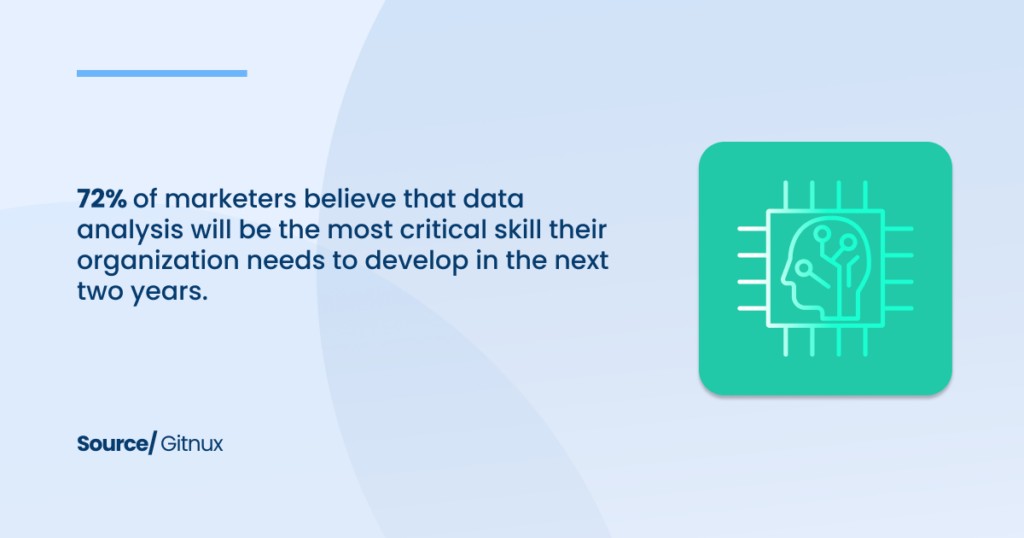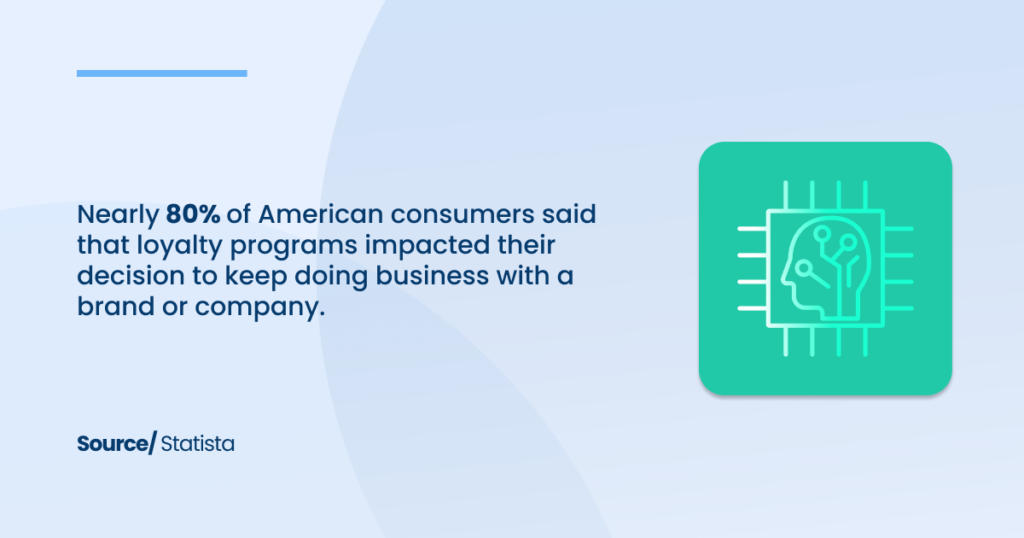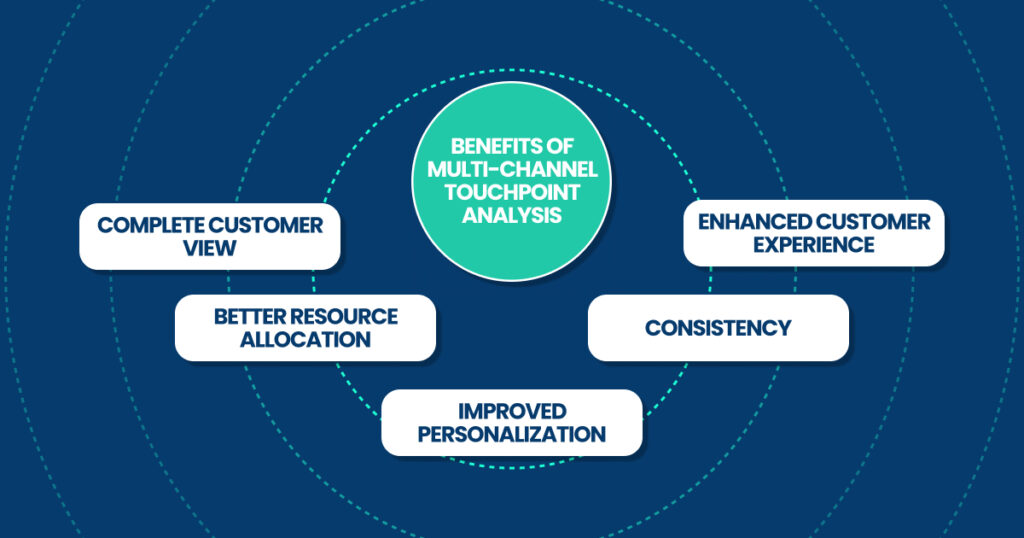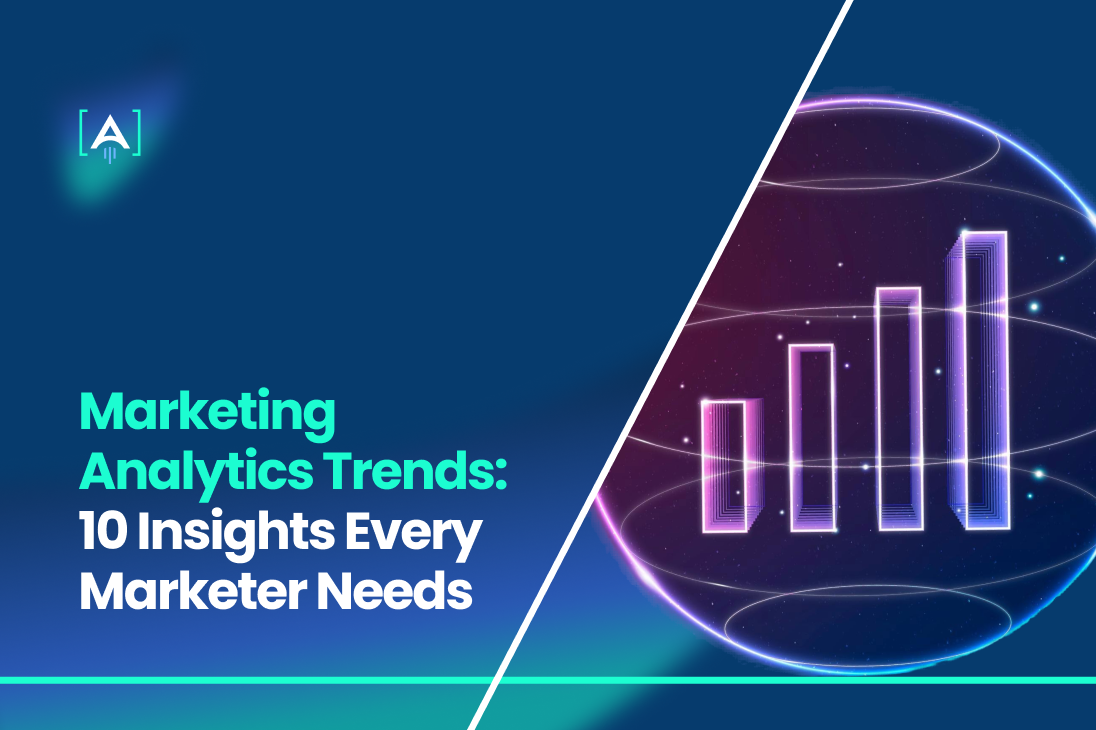You’ve probably heard it a hundred times: marketing analytics is the key to smarter decisions.
But here’s the truth: Many businesses are still stuck on outdated metrics, missing out on marketing analytics trends that could actually drive growth.
What if you could spot customer behavior shifts before your competitors?
Or predict which marketing channels will skyrocket your ROI next quarter?
In this post, we’re exploring 10 trends in marketing analytics every savvy marketer should watch. Ready to turn raw data into business-changing insights?
Let’s get started.
What Is Marketing Analytics?

Source: Gitnux
Marketing analytics involves tracking and evaluating data generated by your marketing activities.
But it’s more than just a report card.
It helps businesses
- understand their audience
- fine-tune campaigns
- improve targeting and increase results
Whether you’re running digital ads, social media campaigns, or email marketing, analytics gives you valuable insights into what’s working and what isn’t.
The growing importance of marketing analytics is reflected in its rapid market expansion.
In 2021, the global marketing analytics software market was valued at $3.9 billion.
By 2031, it’s expected to reach a staggering $14.3 billion, growing at a compound annual growth rate (CAGR) of 13.9%.
What’s fueling this growth?
The rising use of big data and the increasing demand for businesses to understand and predict customer behavior.
Marketing is no longer just about creative campaigns—data-driven insights are at the heart of modern marketing success.
Source: Allied Market Research
Why Marketing Analytics Matters?
Partnering with a Marketing Analytics & Reporting Agency helps businesses fully use their data.
With deeper insights into marketing analytics trends, companies can spot new opportunities, better understand their customers, and adapt strategies to stay ahead of competitors.
Here’s why marketing analytics solutions are so essential:
- Empower smarter decisions: Analytics provide concrete data on what works and what doesn’t, so you can focus your efforts and resources where they deliver the highest ROI.
- Optimize spending and efficiency: With analytics, you can avoid wasted spend on underperforming tactics and channels.
- Understand customer behavior deeply: People value a personal touch. For example, Amazon uses analytics to track what customers browse and buy, allowing them to recommend personalized products.
- Measure success and growth accurately: Analytics lets you track conversion rates, customer acquisition costs, and return on ad spend, giving you a clear view of how well your marketing drives business growth.
The Power of Real-Time Data: Making Decisions Faster
What if you could tweak your marketing campaigns the moment something isn’t working? That’s the beauty of real-time data.
It gives you the power to react instantly, not weeks after a campaign ends.
Today, one of the biggest trends in marketing analytics is the ability to access up-to-the-minute insights that help businesses make quick, smart decisions.
React in Real-Time, Not Retroactively
Think about it: your latest email campaign goes live, and you see open rates dipping within hours.
Instead of waiting for a full report at the end of the month, you can adjust the subject line, change the call to action, or even shift the budget toward better-performing channels—all in real-time.
That’s what real-time data brings to the table.
Fine-Tune Campaigns as They Run
Instead of launching a campaign and crossing your fingers, you now have the tools to adjust mid-flight.
Got an ad that’s falling flat? Switch up the messaging or redirect the spend to another channel immediately.
This is where partnering with experts in marketing analytics consulting helps—they can guide you on how to get the most from these real-time tools and drive better results instantly.
Understand Your Customers on the Go
Customers change, and so should your strategy. Real-time data shows how people engage with your brand right now.
Is there a new trend picking up? Are people responding better to a different product feature?
You can adjust your messaging on the go to meet their evolving needs.
This is what makes marketing analytics trends so critical—staying ahead means adapting in the moment, not after it’s too late.
From Cookies to First-Party Data: A Necessary Evolution
As third-party cookies fade, marketers must shift to first-party data.
Relying on first-party data means collecting information directly from your audience, giving you richer insights and more control.
Leveraging SEO and Web Analytics for Deeper Insights
Without third-party cookies, brands are turning to SEO marketing analytics and web marketing analytics to better understand their audience.
Instead of relying on external data, marketers dig into how visitors interact with their websites.
Facing Privacy and Data Security Head-On
The biggest challenges in this shift are privacy and data security.
Customers are more aware than ever of how their data is used, and businesses must adapt.
This means collecting data ethically, being transparent about its use, and ensuring it’s secure.
How Brands Leverage First-Party Data?
To build trust, brands like Apple have led the way by focusing on user privacy.
Apple’s App Tracking Transparency policy empowers users to control who tracks their data, forcing marketers to prioritize ethical, first-party data collection.
Nike’s Fiscal 2024 Third Quarter success is a testament to how effectively the company leverages first-party data.
Source: Nike Investors
By gathering direct insights from its customers, Nike doesn’t just boost sales—it uses this data to drive product innovation.
Its membership programs and outreach efforts allow it to collect feedback at scale, helping it spot emerging trends early.
Rather than relying on outdated third-party cookies, Nike continuously asks for customer input and refines its products based on real-time feedback.
As privacy concerns grow and third-party tracking declines, this direct approach to data collection has become even more valuable, giving Nike a competitive edge in shaping the next big thing in sportswear.
Adapting with Ethical Data Strategies
So, how do businesses thrive in this new world in 4 simple steps?
Build Direct Relationships
- Focus on gathering first-party data by connecting directly with your audience.
Offer Value for Data
- Provide personalized content, exclusive offers, or loyalty rewards in exchange for customer information.
Prioritize Trust and Transparency
- Clearly communicate how data will be used and ensure privacy protections.
Use Data for Personalized Insights
- Leverage the collected data to create more relevant, tailored marketing strategies.
AI in Marketing Analytics: The Ultimate Advantage
You already know AI is one of the most powerful marketing analytics trends, but here’s something you might not fully appreciate.
AI is now identifying micro-trends and behavioral shifts in real-time, enabling you to act on insights before your competitors even notice them.
AI marketing analytics lies in predicting the unpredictable and dynamically adjusting strategies.
Source: Market.us
Predict Customer Intent with Unseen Signals
AI picks up on micro-behaviors—such as pauses before clicking, changes in browsing habits, or customer service interaction sentiment.
When analyzed at scale, these subtle signals provide early alerts, allowing precise adjustments to your strategy.
Move Beyond Reactive to Proactive Marketing
Traditionally, marketers react to what’s already happened.
But with AI, you can proactively shape customer journeys.
For example, AI can detect when a lead is about to churn before it happens, allowing you to intervene with targeted offers or personalized follow-ups and keeping customers engaged.
Integration of Data Points: CRM, POS, and Loyalty Programs
As businesses expand their digital capabilities, one of the most impactful trends in marketing analytics is integrating multiple data points, including CRM systems, POS transactions, and loyalty programs.
By merging these data sources, companies can get a complete view of the customer journey, from first interaction to final purchase.
This unified approach allows for more informed, data-driven decisions and deeper customer insights.
Why Data Integration Is Essential
The fragmented approach of relying on isolated data sets—such as only using CRM or only tracking sales through POS—no longer cuts it in today’s competitive landscape.
Source: Market.us
To stay ahead, businesses need a complete picture of how customers engage with their brand across various touchpoints.
For example, integrating CRM data with POS systems enables businesses to track who their customers are and how and when they make purchases.
Businesses can more accurately identify purchasing patterns and customer preferences when this data is further enriched with loyalty program insights.
How Integrating CRM and POS Boosts Decision-Making
When a brand’s CRM system captures a customer’s contact information, preferences, and engagement history, it helps marketers personalize communication.
However, adding POS data to the mix clarifies purchasing behavior—how often customers buy, which products they prefer, and how much they typically spend.
How Retailers Use Integrated Data
Consider a clothing retailer that uses both CRM and POS systems. By integrating these data points, the retailer can see who their top customers are and their favorite products and purchase frequencies.
For example, suppose a customer regularly buys a certain brand or product.
In that case, the retailer can use this insight to send targeted offers or notify them when a new collection from that brand arrives.
This CRM and POS data combination enables more personalized marketing efforts, increasing sales and customer satisfaction.
Loyalty Programs: The Missing Piece of the Puzzle

Loyalty programs are another key component in integrating data points.
These programs offer direct insights into customer preferences, allowing businesses to track repeat purchases, rewards redemptions, and overall engagement.
When loyalty data is combined with CRM and POS systems, businesses can identify their most valuable customers and reward them accordingly.
This helps retain these high-value customers, encourages repeat purchases, and fosters long-term brand loyalty.
A 360-Degree View of Customer Behavior
For instance, a coffee shop chain that integrates its loyalty program with CRM and POS systems can track which customers are frequent visitors, what they typically order, and when they prefer to visit.
By using this information, they can offer personalized rewards, such as a discount on the customer’s favorite drink during their usual morning visit.
This integration creates a 360-degree view of customer behavior, leading to more relevant marketing strategies and improved customer experiences.
Data integration can be tricky, but tools like Google Tag Manager and Firebase can help streamline the process.
Make sure data formats and KPIs are consistent across systems for accurate analysis.
Individual-Level Customer Segmentation: Targeting with Precision
One of the key marketing analytics trends gaining traction is individual-level customer segmentation.
Instead of grouping customers into broad categories based on demographics or behaviors, this approach allows businesses to target each customer as unique.
Traditional segmentation might group customers by age, location, or income. While helpful, it’s often too general.
Individual-level segmentation dives deeper into personal habits, such as what products a customer views frequently, how they interact with marketing emails, or which social media posts they engage with.
By knowing these details, marketers can craft personalized messages that are far more relevant to each individual, boosting engagement and conversions.
How It Works
This type of segmentation relies heavily on AI marketing analytics and machine learning tools.
Platforms like HubSpot or Salesforce can analyze data from various touchpoints—email, social media, and website activity—and use it to create tailored marketing experiences for each customer.
Source: Salesforce
For example, suppose a customer consistently browses a specific category on a website but hasn’t made a purchase.
In that case, the system might automatically send them a personalized discount or product recommendation to encourage conversion.
Multi-Channel Touchpoint Analysis: Understanding the Full Customer Journey

One of the key trends in marketing analytics is multi-channel touchpoint analysis. Customers interact with brands across many platforms—websites, mobile apps, social media, and customer support.
By analyzing these different touchpoints, businesses can see how customers move across channels and better understand their entire journey.
Why This Matters
Customers no longer stick to one platform.
They may find your brand on social media, browse your website, and make the final purchase on your mobile app.
You miss the full story if you only look at these touchpoints separately.
Web marketing analytics and mobile marketing analytics can help you track how customers engage on different platforms and which paths lead to sales.
How to Analyze Multi-Channel Touchpoints
Google Analytics, for example, helps you track user behavior across your website, mobile apps, and social media.
For example, you can see how many users click from a social media ad to your site and how they interact once there.
Adding insights from social media marketing analytics or customer support interactions helps you understand your customers’ needs.
10 Key Takeaways for Marketers
- Shift to First-Party Data: Rely on customer-provided data as third-party cookies disappear, ensuring more accurate and personalized insights.
- Use AI for Predictive Analytics: Leverage AI to forecast customer behavior and make smarter, real-time marketing decisions.
- Focus on Individual-Level Segmentation: Personalize campaigns based on customers’ unique actions to boost engagement and sales.
- Optimize Campaigns in Real Time: Use real-time data to adjust ongoing campaigns instantly for better performance.
- Integrate Data Sources: Combine CRM, POS, and loyalty program data for a complete view of the customer journey.
- Track Multi-Channel Touchpoints: Analyze customer interactions across websites, apps, social media, and support to improve their journey.
- Prioritize Privacy and Transparency: Be upfront about data use and offer value in exchange for building trust with your audience.
- Adopt Advanced Tools: Use platforms like Google Analytics and Firebase to streamline data integration and tracking.
- Refine Customer Experience: Use multi-channel and individual marketing data insights to enhance personalization and customer satisfaction.
- Stay Ahead with Marketing Analytics Trends: Monitor new trends and tools to keep your strategies effective and competitive.
Stay Ahead with Data-driven Marketing
Leveraging the latest marketing analytics trends is key to staying competitive.
But staying on top of these trends and managing complex data isn’t always easy. That’s where expert help comes in.
At Azarian Growth Agency, we help businesses make sense of their data, providing tailored solutions through our marketing analytics services.
We empower companies to unlock deeper insights, optimize campaigns in real-time, and ultimately drive growth with the latest marketing analytics solutions.

